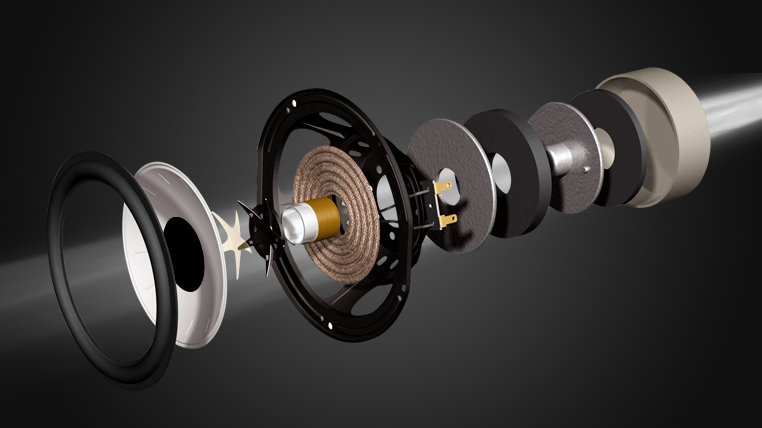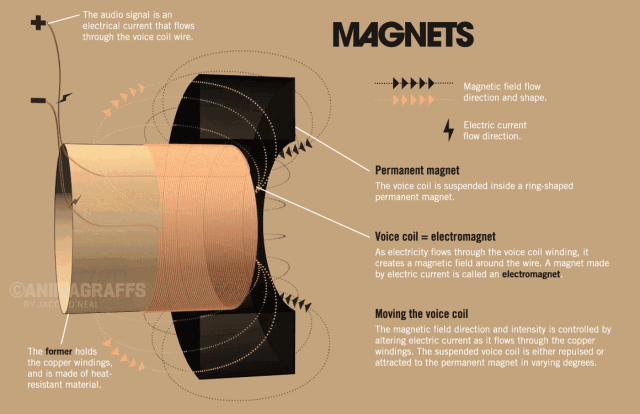Application of magnets on speakers
The core component responsible for producing sound in audio equipment is the speaker, commonly known as the speaker, whether it is a speaker or a headset, this key component is indispensable. The loudspeaker is a kind of transducer device that transforms the electric signal into the acoustic signal. The performance of the loudspeaker has a great influence on the sound quality. To understand speaker magnetism, you must first start with the sounding principle of the speaker.

The sound principle of the horn
The side view of the speaker below can help us understand the basic structure of the speaker. The horn is generally composed of T iron, magnet, voice coil and diaphragm.
So how does the speaker make a sound? We all know that a magnetic field will be generated in the energized wire. The strength of the current affects the strength of the magnetic field (the direction of the magnetic field follows the right-hand rule). When the AC audio current passes through the coil of the speaker (ie the voice coil), according to the above principle A corresponding magnetic field is generated. This magnetic field generates an interaction force with the magnetic field generated by the magnet on the horn. This force causes the voice coil to vibrate in the horn's magnetic field with the strength of the audio current. The diaphragm and the voice coil of the horn are connected together. When the voice coil and the horn diaphragm vibrate together, it pushes the surrounding air to vibrate, and the speaker produces sound. As shown in the figure below, this is the principle of the speaker.


The effect of magnet performance on the sound output quality of speakers
In the case of the same magnet volume and the same voice coil, the performance of the magnet has a direct impact on the sound quality of the speaker:
The greater the magnetic flux density (magnetic induction) B of the magnet, the stronger the thrust acting on the sound film.
The greater the magnetic flux density (magnetic induction) B, the higher the relative power, and the higher the SPL sound pressure level (sensitivity).
The earphone sensitivity is the sound pressure level that the earphone can emit when a 1mw, 1khz sine wave is input to the earphone. The unit of sound pressure is dB (decibel). The greater the sound pressure, the greater the volume, so the higher the sensitivity, the lower the impedance, and the easier it is for headphones to produce sound.
The greater the magnetic flux density (magnetic induction) B, the lower the overall quality factor Q value of the speaker.
Q value (qualityfactor) refers to a set of parameters of the damping coefficient of the horn, where Qms is the damping of the mechanical system, which reflects the energy absorption and consumption of the various parts of the horn. Qes is the damping of the power system, which is mainly reflected in the consumption of electric energy by the DC resistance of the voice coil; Qts is the total damping, which is related to the above two as Qts=Qms*Qes/(Qms+Qes).
The greater the magnetic flux density (magnetic induction) B, the better the transient state.
Transient can be understood as "fast response" to the signal, and the Qms is relatively high. Headphones with good transient response should respond as soon as the signal comes, and stop abruptly as soon as the signal stops, and never sloppy. For example, the transition from the lead to the ensemble is the most obvious in drums and symphonies with larger scenes.
How to choose a horn magnet
There are three main types of speaker magnets on the market: AlNiCo, Ferrite and NdFeB:
Alnico is the earliest magnet used in speakers, such as horn speakers (known as tweeters) in the 50s and 60s. Generally made into internal magnetic horn (external magnetic type is also available). The disadvantage is that the power is small, the frequency range is narrow, hard and brittle, and the processing is very inconvenient. In addition, cobalt is a scarce resource, and the price of AlNiCo is relatively high. From the perspective of cost performance, horn magnets choose AlNiCo to be relatively small.
Ferrites are generally made of external magnetic speakers. Ferrites have relatively low magnetic properties and require a certain volume to meet the driving force of the speakers. Therefore, they are generally used in larger audio speakers. The advantage of ferrite is that it is cheap and cost-effective; the disadvantage is that it is larger in size, smaller in power, and narrow in frequency range.
The magnetic properties of NdFeB are far superior to AlNiCo and ferrite, and it is currently the most used magnet on speakers, especially high-end speakers. Its advantages are its small size, high power, and wide frequency range under the same magnetic flux. At present, HiFi headsets basically use such magnets. The disadvantage is that because it contains rare earth elements, the material price is relatively high.
Several factors to consider when choosing a horn magnet
First of all, it is necessary to clarify the ambient temperature where the horn is working, and determine which magnet should be selected according to the temperature. Different magnets have different temperature resistance characteristics, and the maximum operating temperature that can be supported is also different. When the working environment temperature of the magnet exceeds the maximum working temperature, magnetic performance degradation and demagnetization may occur, which will directly affect the sound effect of the horn.
Secondly, it is necessary to comprehensively consider the magnetic flux requirements and the volume of the magnet to select the horn magnet. Someone asked if the louder the speaker magnet, the better the sound? In fact, the speaker is not the bigger the magnet, the better. From the influence of magnet performance on the sound output quality of the horn, we can find that the magnetic flux of the magnet has a great influence on the sound quality of the horn. In the case of the same volume, the performance of the magnet: neodymium iron boron> alnico> ferrite; at the same magnetic flux Under the requirements, the volume of neodymium iron boron magnet is the smallest, and the ferrite is the largest. The same magnetic material (same material and same performance), the larger the diameter, the greater the magnetic induction, the greater the power of the speaker, the higher the sensitivity of the speaker, and the better the transient response. Therefore, it is necessary to comprehensively consider the limitation of the volume of the horn on the volume of the magnet and the requirements of the magnetic flux performance of the magnet to determine which magnetic material to choose.
